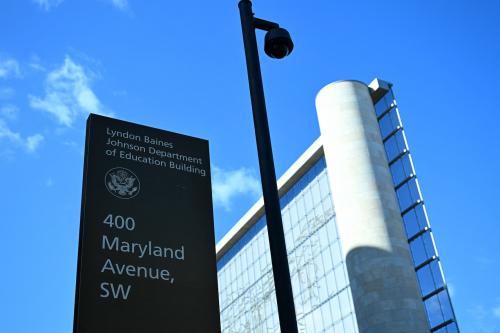This letter, addressed to Secretary Steve Mnuchin, is a formal comment in response to the Department of Treasury, Financial Crimes Enforcement Network’s Advance Notice of Proposed Rulemaking, Anti-Money Laundering Program Effectiveness, Docket No. FINCEN-2020-0011. The notice was published September 17, 2020.
Dear Secretary Mnuchin,
Thank you for the opportunity to comment on the Department of Treasury (Treasury) Financial Crimes Enforcement Network (FinCEN) Advance Notice of Proposed Rulemaking titled “Anti-Money Laundering Program Effectiveness” and published on September 17, 2020 in the Federal Register (“the Notice”). I am Aaron Klein, a fellow in the Economic Studies program and policy director of the Center on Regulation and Markets at the Brookings Institution.
I commend Treasury for conducting this review. Current anti-money laundering (AML) programs are in substantial need of reform. A thesis of AML has been that increasing compliance costs for financial institutions will discourage serving high-risk customers. This thesis has counterproductive outcomes. AML compliance costs are not correlated with customer profitability, which is the main driver of whether an entity can secure a banking relationship. The result has been an increase in regulatory costs that discourage serving low-income/low profit customers, while high risk but profitable/wealthy customers remain able to secure banking relationships, even if they have to pay more for them. This harms lower income people who need access to the financial system for legitimate purposes while failing to deliver on the goal of restricting criminals’ access to the financial system.
To enhance AML program effectiveness, a new thesis should be adopted. Encourage financial institutions to devote substantial resources to effectively identifying high-risk entities. Require law enforcement to use this data to more wisely target resources and catch criminals, instead of using the data as a check of other criminal activity after wrong doing had been identified elsewhere. Under this regime, the purpose of AML compliance by financial institutions will be to provide high quality information to serve key strategic law enforcement objectives. The current regime’s focus on the production of documents without sufficient feedback on the quality or effectiveness of the information should be considered a failure, not a success. Raising fixed costs to serve a consumer is counter productive, while targeting resources to higher risk customers is beneficial.
In addition to this overall change, this letter details three specific additional changes that would increase AML effectiveness and achieve objectives consistent with the Notice. Namely that FinCEN should:
- Embrace new financial technology (FinTech) capabilities to increase financial inclusion and reduce compliance costs for financial institutions serving the underserved.
- Prioritize financial elder abuse as a key objective resulting from information gathered from AML programs. To achieve this objective, FinCEN should convene a working group among state and federal elder abuse experts to make the SARs database more useful and provide greater guidance about filing elder abuse SARs in an actionable way for law enforcement.
- Treat state-licensed marijuana businesses, employees and counterparties, and state, tribal and local governments who derive revenue from taxation of such businesses similar to all other businesses and counterparties for purposes of AML compliance.
Please see below for additional details and pertinent support:
1. New technologies
Recommendation E: Advance Regulatory Innovations of the Notice states that the Anti-Money Laundering (AML) regime should “promote the use of responsible innovations to address new and emerging money laundering and terrorist financing risks.” Innovations in financial technology (Fintech) provide the opportunity to better detect financial malfeasance through more targeted detections. It is hard to believe that the sharp growth in SARs filings by financial institutions over the past decade is driven by increased suspicious activities taking place within the financial system, but rather it is a function of a series of regulatory decisions designed to create incentives to maximize quantity over quality. American financial institutions spend an estimated $50 billion per year in AML compliance costs, yet estimates are they catch less than one percent of the estimated $2 trillion in financial crime committed each year. As then-Harvard University now Alliance for Innovative Regulation’s Jo Ann Barefoot put it, “law enforcement agencies lament that the data they receive today is low in value, containing too much unimportant information and lacking queriable formats that could help them readily find key material and detect patterns of crime.”
FinCEN should be focused on outputs, prioritizing quality over quantity, while remaining technologically neutral. FinTech is evolving faster than regulations are updated. Hence requiring specific technologies be used, or de facto requiring such usage, retards innovation and evolution. The general goals of getting things done, better, faster, cheaper, ought to apply as much in AML as in other areas. Rewarding traditional systems because of their historic usage negates the potential to improve the AML system. Improvement must be measured by the quality of information, not quantity. As noted above, the vast increase in SARs filings is not evidence of increased success of AML; To the contrary, it is evidence of a system producing more information than can be consumed.
Clearer guidance by FinCEN in coordination with international standards setting bodies can be particularly important to incorporating new FinTech as part of processing cross-border payments (remittances). This is critical in the fight for greater financial inclusion and against the ‘de-risking’ phenomena. Cross-border payment risks can be ameliorated by technologies that enable direct, point-to-point settlement, which eliminates the need for many of the current costly operational processes. The innovation of a portable digital identity offers the possibility for payments information to be traced, allowing greater transparency. Finally, FinTech also allows for more effective collaboration between financial institutions and law enforcement agencies by providing platforms for secure and meaningful public-private collaboration, while preserving privacy and commercial confidentiality.
AML enforcement is a genuine resource challenge: time, funding, and human capital alike. In response to resource challenges, firms often try to find efficiencies. However, the AML policy response to a serious resource challenge has been to generate even greater resource challenges via the snowballing of existing inefficiencies.
2. Suspicious Activity Reports (SARS) on elder exploitation
Question three of the Notice requests different or additional mechanisms to “increase the effectiveness of AML programs.” FinCEN further describes considering “Strategic AML Priorities” as part of their risk assessment process for financial institutions. FinCEN should include as part of these strategic priorities detecting and deterring financial elder abuse. A starting point is to convene a working group among state and federal elder abuse experts to make the SARs database more useful and provide greater guidance about filing elder abuse SARs in an actionable way for law enforcement. This must include law enforcement and other officials dedicated to protecting the elderly, not just traditional law enforcement. The output from this working group should help inform a sustained effort to focus on financial crimes against the elderly.
Elder financial abuse is widespread and damaging. Crimes committed against the elderly, swindling them out of substantial sums of money are inherently financial in nature. Financial crimes such as elder abuse are designed to be detected as part of an anti-money laundering regime. However, many cases are avoiding detection under current AML reporting systems. According to the Consumer Financial Protection Bureau (CFPB) only two percent reported of an estimated 3.5 million cases of elder abuse triggered the filing of a suspicious activity report (SAR). This despite an increase in filings that now reach $1.7 billion in elder financial abuse SARs. The Consumer Financial Protection Bureau has repeatedly suggested that financial institutions report all suspected EFE to appropriate local, state, or federal responders and clarified that doing so does not generally violate privacy laws. Still, less than one third of these SARs say that the filing institution reported the suspicious activity to authorities. Thus, two-thirds of institutions simply file and leave it at that, producing little likelihood that the SAR will start an investigation.
Elder abuse is likely to grow substantially due to demographics alone. By 2034 there will be 77 million Americans over the age of 65, the first time in American history the elderly will outnumber children, according to the Census Department. This will trigger what is being called, ‘the largest transfer of wealth in history’ as those fortunate enough to have saved are estimated to have $68 trillion in potential wealth to transfer to heirs. Now is the time to strengthen our systems of elder abuse detection and mitigation.
Financial institutions are critical to this mission. As the National Center of Elder Abuse found: “banks are in a good position to observe financial abuse and concerted attention should be given to how to better involve them.” Further, as many of the elder abuse laws and law enforcement are state and local in nature, the SARs database is well situated to provide information to the widespread decentralized network charged with detecting these crimes. In addition, research indicates that adult protective services caseworkers, who are the front line of investigating these types of crimes, believe “that officials in the criminal justice system (law enforcement, prosecutors) were unhelpful to them in investigating elder abuse, in general, and financial exploitation in particular.” Given the ability of SARs and other AML information to lead to successful prosecution of AML related crimes, this makes it even more important for AML resources to be prioritized to addressing elder financial abuse.
Greater integration between law enforcement, financial institutions, elder abuse specialists and caseworkers, and others are required for AML officials, financial institutions, and law enforcement. This necessitates leadership and focus, two attributes that the Treasury Department can and should provide in elevating elder protection. Treasury has an apt potential partner in the CFPB, which has already devoted substantial resources to addressing this issue. Treasury should involve CFPB and other financial regulators as well as financial institutions as part of this roundtable, developing a strategy that prioritizes combating elder financial abuse.
3. State-licensed Marijuana businesses
As another mechanism to “increase the effectiveness of AML programs,” FinCEN should allow banks and credit unions to treat state-licensed marijuana businesses as any other business (no extra required SARs filing). By doing this, vital resources currently aimed at tracking marijuana companies can be refocused to address areas of risk and national AML priorities.
Current regulations require banks to file suspicious-activity reports (SARs) on customers that are suspected of depositing revenue from illegal activities. This is a logical and important requirement as the SAR is a key element used to detect illegal activity and alert law enforcement as to individuals who are conducting illegal action. It is also an expensive proposition and an error in filing opens financial institutions to potentially significant fines and sanctions. After identifying a customer as suspicious, the financial institution has to continually file information. This make sense under the assumption that the criminal is attempting to hide illegal activity and the financial profits of that activity are a clue that illicit behavior is occurring.
The core assumptions regarding SARs filing fail in the case of individuals and corporations engaged in state licensed cannabis. These entities are not hiding their operations, but rather are conducting them in plain sight. They are identifying themselves in multiple public documents available to law enforcement at any and all level. If law enforcement wants to find state licensed cannabis activity it is more effective and efficient to use Google maps than the SARs database.
Partially recognizing the absurdity of the situation as it relates to state licensed and regulated cannabis, FinCEN has issued various guidance to financial institutions for serving state licensed cannabis and hemp entities. However, these existing regulations are insufficient. As evidence, most banks and credit unions are not serving cannabis businesses—only one in thirty bank and credit unions report that they do so. As a result of under-banking in the industry, marijuana businesses end up sending trucks of cash to trigger additional rounds of AML reporting by financial institutions on businesses. Current AML regulations are inefficient, counter productive, and an increasingly growing problem as marijuana becomes commercialized in more states (see 2020 election results in New Jersey, Arizona, and other states). In addition, high costs for financial institutions to serve cannabis companies are particularly burdensome for smaller credit unions, community banks, and minority owned depository institutions many of which have considered serving this growing industry.
The result of driving cannabis businesses out of the banking system generates greater law enforcement risks and reduces public safety. As FinCEN and Treasury are well aware, businesses dependent on cash and excluded from the banking system create opportunity for greater crime and hamper law enforcement’s ability to identify criminal activity. The irony of FinCEN’s approach to cannabis is that it protects banks not people or communities.
The solution is simple. If a cannabis company or individuals associated with such an enterprise are state licensed, they should be treated as any other business for AML purposes. This should extend to their counterparties, including state and local governments that deposit tax revenue from these activities. If there are reasons to believe that company is conducting additional illicit activity it should and must be subject to additional scrutiny. This may be the case more frequently in these companies than in general business and FinCEN should work with law enforcement and financial institutions to develop appropriate guidelines. However, using financial institutions as the first line of identification for illicit activity among state licensed cannabis companies is illogical. It is time for FinCEN to acknowledge that and move beyond its initial, now outdated cannabis compliance regime.
It is past time to revisit basic assumptions regarding the AML regime. I commend FinCEN and Treasury more broadly for soliciting comments on this topic and indicating a willingness to rethink the system. Changes in financial technology, the growth in elder financial abuse, and the rise of state licensed cannabis all present significant challenges and opportunities for AML reform. The ability to substantially alter the current system to address new reality will determine whether we are more efficient and effective in achieving the shared goals of an inclusive financial system that dedicates significant resources to effectively fight crime and protect our most vulnerable citizens.
Sincerely,
Aaron Klein
Fellow, Economic Studies, Brookings Institution
Isabella Dunbar contributed substantially to the research and analysis that supported this comment letter
The Brookings Institution is committed to quality, independence, and impact.
We are supported by a diverse array of funders. In line with our values and policies, each Brookings publication represents the sole views of its author(s).







